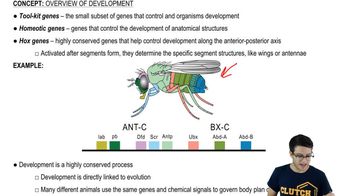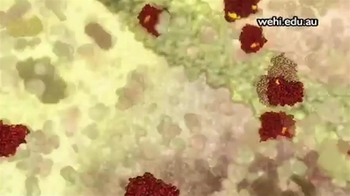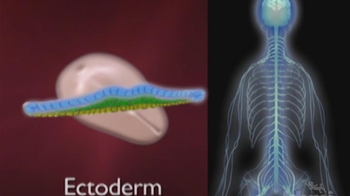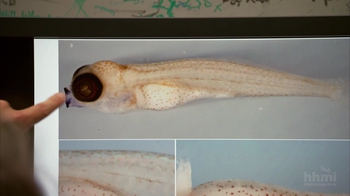Table of contents
- 1. Introduction to Biology2h 42m
- 2. Chemistry3h 40m
- 3. Water1h 26m
- 4. Biomolecules2h 23m
- 5. Cell Components2h 26m
- 6. The Membrane2h 31m
- 7. Energy and Metabolism2h 0m
- 8. Respiration2h 40m
- 9. Photosynthesis2h 49m
- 10. Cell Signaling59m
- 11. Cell Division2h 47m
- 12. Meiosis2h 0m
- 13. Mendelian Genetics4h 44m
- Introduction to Mendel's Experiments7m
- Genotype vs. Phenotype17m
- Punnett Squares13m
- Mendel's Experiments26m
- Mendel's Laws18m
- Monohybrid Crosses19m
- Test Crosses14m
- Dihybrid Crosses20m
- Punnett Square Probability26m
- Incomplete Dominance vs. Codominance20m
- Epistasis7m
- Non-Mendelian Genetics12m
- Pedigrees6m
- Autosomal Inheritance21m
- Sex-Linked Inheritance43m
- X-Inactivation9m
- 14. DNA Synthesis2h 27m
- 15. Gene Expression3h 20m
- 16. Regulation of Expression3h 31m
- Introduction to Regulation of Gene Expression13m
- Prokaryotic Gene Regulation via Operons27m
- The Lac Operon21m
- Glucose's Impact on Lac Operon25m
- The Trp Operon20m
- Review of the Lac Operon & Trp Operon11m
- Introduction to Eukaryotic Gene Regulation9m
- Eukaryotic Chromatin Modifications16m
- Eukaryotic Transcriptional Control22m
- Eukaryotic Post-Transcriptional Regulation28m
- Eukaryotic Post-Translational Regulation13m
- 17. Viruses37m
- 18. Biotechnology2h 58m
- 19. Genomics17m
- 20. Development1h 5m
- 21. Evolution3h 1m
- 22. Evolution of Populations3h 52m
- 23. Speciation1h 37m
- 24. History of Life on Earth2h 6m
- 25. Phylogeny2h 31m
- 26. Prokaryotes4h 59m
- 27. Protists1h 12m
- 28. Plants1h 22m
- 29. Fungi36m
- 30. Overview of Animals34m
- 31. Invertebrates1h 2m
- 32. Vertebrates50m
- 33. Plant Anatomy1h 3m
- 34. Vascular Plant Transport1h 2m
- 35. Soil37m
- 36. Plant Reproduction47m
- 37. Plant Sensation and Response1h 9m
- 38. Animal Form and Function1h 19m
- 39. Digestive System1h 10m
- 40. Circulatory System1h 57m
- 41. Immune System1h 12m
- 42. Osmoregulation and Excretion50m
- 43. Endocrine System1h 4m
- 44. Animal Reproduction1h 2m
- 45. Nervous System1h 55m
- 46. Sensory Systems46m
- 47. Muscle Systems23m
- 48. Ecology3h 11m
- Introduction to Ecology20m
- Biogeography14m
- Earth's Climate Patterns50m
- Introduction to Terrestrial Biomes10m
- Terrestrial Biomes: Near Equator13m
- Terrestrial Biomes: Temperate Regions10m
- Terrestrial Biomes: Northern Regions15m
- Introduction to Aquatic Biomes27m
- Freshwater Aquatic Biomes14m
- Marine Aquatic Biomes13m
- 49. Animal Behavior28m
- 50. Population Ecology3h 41m
- Introduction to Population Ecology28m
- Population Sampling Methods23m
- Life History12m
- Population Demography17m
- Factors Limiting Population Growth14m
- Introduction to Population Growth Models22m
- Linear Population Growth6m
- Exponential Population Growth29m
- Logistic Population Growth32m
- r/K Selection10m
- The Human Population22m
- 51. Community Ecology2h 46m
- Introduction to Community Ecology2m
- Introduction to Community Interactions9m
- Community Interactions: Competition (-/-)38m
- Community Interactions: Exploitation (+/-)23m
- Community Interactions: Mutualism (+/+) & Commensalism (+/0)9m
- Community Structure35m
- Community Dynamics26m
- Geographic Impact on Communities21m
- 52. Ecosystems2h 36m
- 53. Conservation Biology24m
20. Development
Developmental Biology
Problem 1`
Textbook Question
What is apoptosis?
a. An experimental technique used to kill specific cells
b. Programmed cell death that is required for normal development
c. A pathological condition observed only in damaged or diseased organisms
d. A developmental mechanism unique to the roundworm C. elegans
 Verified step by step guidance
Verified step by step guidance1
Understand the term 'apoptosis': Apoptosis is a biological process that refers to programmed cell death, which is a normal and controlled part of an organism's growth or development.
Consider the role of apoptosis in development: Apoptosis is crucial for shaping organs and tissues during development by removing unnecessary or damaged cells.
Differentiate apoptosis from pathological cell death: Unlike necrosis, which is a form of traumatic cell death resulting from acute cellular injury, apoptosis is a regulated and orderly process.
Recognize the universality of apoptosis: Apoptosis is not unique to any single organism, such as C. elegans, but is a common mechanism across many species, including humans.
Evaluate the options: Based on the understanding of apoptosis, identify that it is best described by option b, as it is a programmed cell death required for normal development.
 Verified video answer for a similar problem:
Verified video answer for a similar problem:This video solution was recommended by our tutors as helpful for the problem above
Video duration:
2mPlay a video:
Was this helpful?
Key Concepts
Here are the essential concepts you must grasp in order to answer the question correctly.
Apoptosis
Apoptosis is a form of programmed cell death that is essential for maintaining healthy tissue homeostasis and development. It involves a series of biochemical events leading to characteristic cell changes and death, allowing the removal of unnecessary or damaged cells without causing inflammation.
Recommended video:
Guided course

Cellular Interactions and Apoptosis
Normal Development
Normal development refers to the process by which organisms grow and develop in a regulated manner, involving cell differentiation, growth, and death. Apoptosis plays a crucial role in this process by eliminating cells that are no longer needed, thus shaping organs and tissues during embryonic development.
Recommended video:
Guided course

Embryonic Plant Development
Programmed Cell Death
Programmed cell death is a controlled process by which cells self-destruct in response to specific signals. Unlike necrosis, which is a form of traumatic cell death, programmed cell death like apoptosis is a vital mechanism for removing cells in a way that prevents damage to surrounding tissues.
Recommended video:
Guided course

Cell Cycle Regulation

 5:28m
5:28mWatch next
Master Cell Division and Differentiation with a bite sized video explanation from Jason
Start learningRelated Videos
Related Practice



























![Drosophila Embryogenesis - Anterior/Posterior Patterning [English Captions]](https://img.youtube.com/vi/ZOzKXrOGtgw/mqdefault.jpg)



















